AUDI TT COUPE 2017 Owners Manual
Manufacturer: AUDI, Model Year: 2017, Model line: TT COUPE, Model: AUDI TT COUPE 2017Pages: 322, PDF Size: 79.73 MB
Page 221 of 322

CD
CD
.... N
" N ...... 0
0
Ill co
below the reference value programmed into the
control unit, the side curtain airbag will not be
tr iggered, even though the car may be bad ly
damaged as a result of the collision. It is not pos
sible to define an airbag triggering range that
will cover every possib le angle of impact, since
the circumstances will vary considerably between one co llision and another. Important factors in
clude, for example, the nature (hard or soft) of
the impacting object, the angle of impact, vehicle speed, etc.¢
page 219, How side curtain air
bags work.
Aside from their normal safety function, safety
be lts work to help keep the d river or fron t pas
senger in posit ion in the event of a co llision so
that the side curtain airbags can provide protec
tion.
The airbag system is not a s ubst itu te for yo ur
safety belt. Rather, it is part of the overa ll occu
pant restraint system in your vehicle. Always re
member that the airbag system can only help to
protect you if you are wearing your safety belt
and wear ing it properly . This is another reason
why you should always wear your safety belts,
not just because the law requires you to do so
¢ page 189, General notes.
It is important to remember that while the side
curtain airbag system is des igned to help reduce
the likelihood of serious injuries, other injuries,
for example, swelli ng, bruising, fr iction burns
and minor abrasions can also be associated with
these airbags upon deployment . Remember too,
these airbags will deploy only once and only in certa in kinds of acc idents - you r safety belts are
always there to offer protection.
The side curtain airbag system basically
consists of:
- T he elec tronic contro l module and external side
impact sensors
- T he side c urtain airbags above the front and
rea r side windows with ejection mitigation fea
tures
- T he airbag indicator light in the instrument
panel
The airbag system is monitored elec tronically to
make certain it is f unct ion ing properly at all
Airb ag sys tem
times. Each time you switch on the ignition, the
airbag system indicator light wi ll come on for a
few seconds (self d iagnostics).
Th e side curtain airbag is not activ ated:
- if the igni tion is sw itched off,
- in side co llisions when the accele ration meas-
ured by the sensor is too low,
- in rear-end co llisions.
A WARNING
- Safety belts an d the airbag system will only
p rovide protect ion when occup ants are in
the proper seat ing position ¢
page 44,
Seats and storage .
- If the airbag ind ic a tor light~ page 15
comes when the veh icle is being used, have
the system inspected immediately by your
authorized Audi dealer . It is possib le that
the airbag will inflate when it is not sup
posed to, or w ill not inf late when it should.
How side curtain airbags work
Side curtain airbags con work together with side
airbags to help reduce the risk of head and upper
torso injuries for occupants who ore properly re
strained.
Fig. 169 Illustration of princip le: Inflated s ide curta in air
bags on the left s ide
The side curtain airbags inflate between the oc
cupant and the windows on the side of the vehi-
cle that is struck in a side collision
¢fig . 169 .
When the system is triggered, the side curtain
airbag is filled with propellant gas and breaks
through a seam above the front and rear side
windows identified by the AIRBAG label. In order
liJ,
219
Page 222 of 322
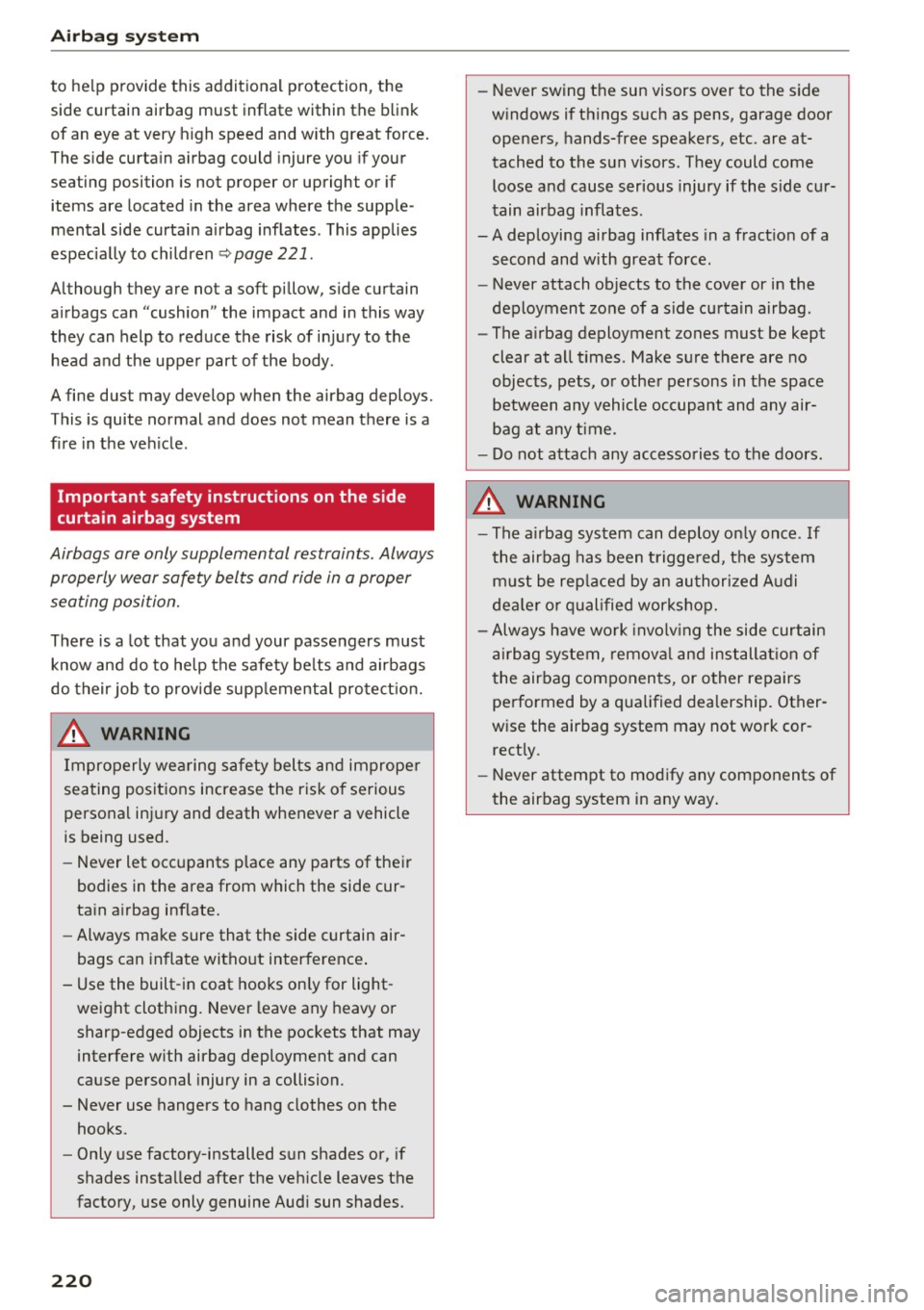
Airbag syste m
to help provide this additional protection, the
side curtain airbag must inflat e within th e blink
of an eye at very h igh speed and with great force .
The side curtain airbag could injure you if your seating position is not proper or upright or if
items are located in the area where the supple
mental side curtain airbag inflates . This applies
especia lly to children
~ page 221 .
Although they are not a soft pillow, side curtain
airbags can "cushion" the impact and in this way
they can help to reduce the risk of injury to the head and the upper part of the body .
A fine dust may develop when the airbag deploys.
This is quite normal and does not mean there is a
fire in the veh icle.
Important safety instructions on the side
curtain airbag system
Airbags are only supplemental restraints . Always
properly wear safety belts and ride in a proper
seating position.
There is a lot that you a nd your passengers must
know and do to help the safety be lts and airbags
do their job to provide supp lemental protect ion.
_& WARNING
Improperly wearing safety belts and improper
seating positions increase the risk of serious
personal injury and death whenever a vehicle
is being used.
- Never let occupants p lace any parts of their
bodies in the area from which the side cur
ta in a irbag inflate.
- Always make sure that the side curtain air
bags can inflate without interference .
- Use the built -in coat hooks on ly for light
weight clothing. Never leave any heavy or sharp-edged objects in the pockets that may
interfere w ith airbag deployment and can
cause personal injury in a collision.
- Never use hangers to hang clothes on the hooks.
- Only use factory-installed sun shades or, if
shades installed after the veh icle leaves the
factory, use only genuine Aud i sun shades .
220
-Never swing the sun visors over to the side
w indows if things such as pens, garage door
openers, hands-free speakers, etc. are at
tached to the sun visors . They could come
loose and cause serious injury if the side cur
tain airbag inflates.
- A deploying airbag inflates in a fract ion of a
second and with great force.
- Never attach objects to the cover or in the
deployment zo ne of a s ide curtain airbag .
- The a irbag deployment zones must be kept
clear at all times . Make sure there are no
objects , pets, or other persons in the space
between any vehicle occupant and any air
bag at any time .
- Do not attach any accessories to the doors .
_& WARNING
-The a irbag system can deploy on ly once . If
the airbag has been trigge red, the system
m ust be rep laced by an authorized A udi
dea le r o r qualified workshop.
- Always have wo rk invo lv ing the side curtain
airbag system, remova l and installat ion of
the airbag components, or other repairs
performed by a q ualified dealership. Other
wise the airbag system may not work cor
rectly .
- Never attempt to mod ify any components of
the airbag system in any way .
Page 223 of 322
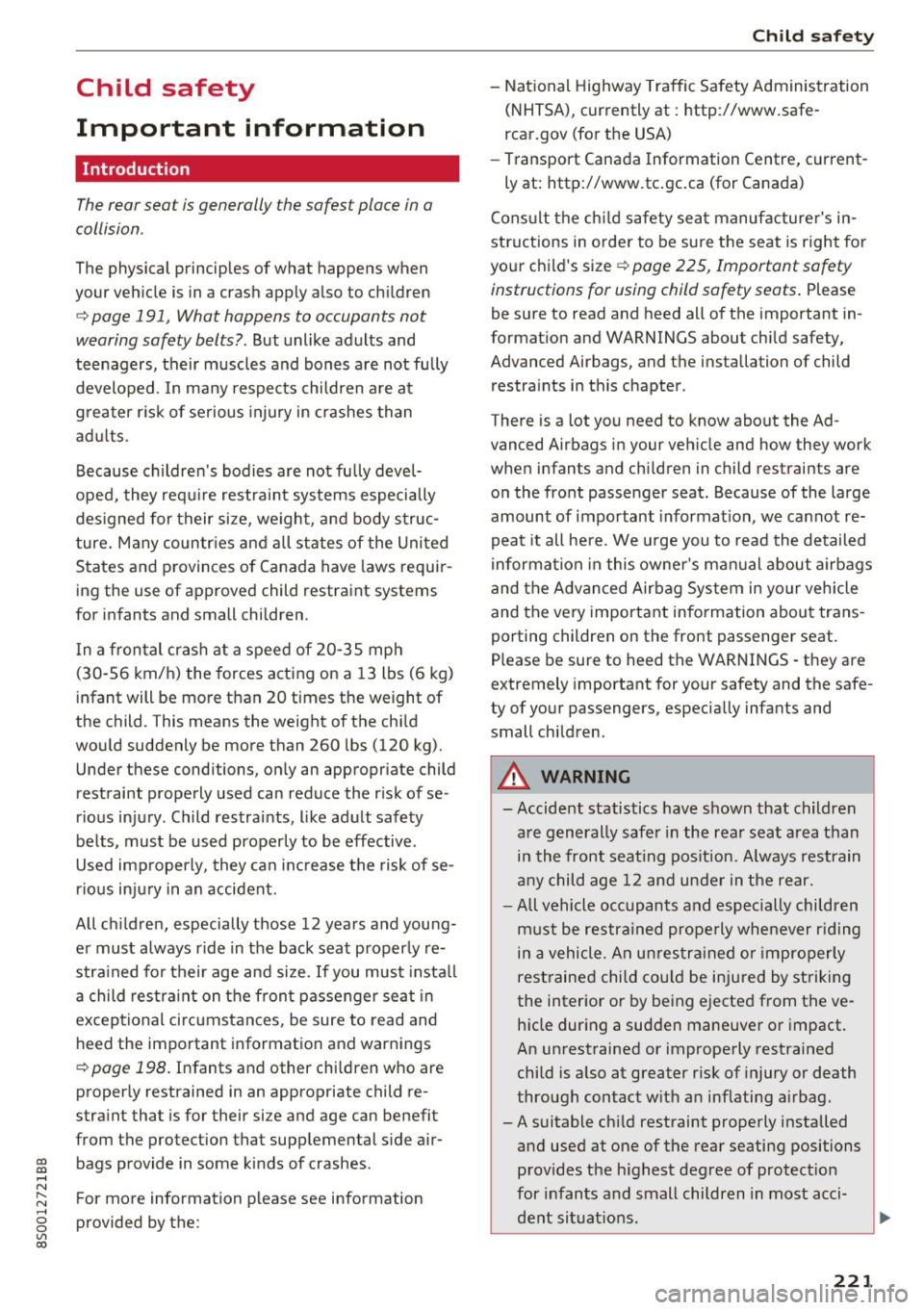
co
co
.... N
" N .... 0
0
Vl c:o
Child safety
Important information
Introduction
The rear seat is generally the safest place in a
collision .
The physical principles of what happens when
your vehicle is in a crash apply also to children
c:> page 191, What happens to occupants not
wearing safety belts? .
But unlike adults and
teenagers, their muscles and bones are not fully
developed. In many respects children are at
greater r isk of serious injury in crashes than
adults .
Because children's bodies are not fu lly devel
oped, they requ ire restraint systems especially
des igned for their size, we ight, and body struc
ture. Many countr ies and all states of the United
States and provinces of Canada have laws requir
ing the use of approved child restraint systems
for infants and small children .
I n a frontal crash at a speed of 20- 3 5 mph
(30-56 km/h) the forces acting on a 13 lbs (6 kg)
infant will be more than 20 times the weight of
the child . This means the weight of the chi ld
would suddenly be more than 260 lbs (120 kg). Under these conditions, only an appropriate child
restraint properly used can reduce the risk of se
rious injury . Child restraints, l ike adult safety
belts, must be used properly to be effective .
Used imp roperly, they can increase the risk of se
rious injury in an accident.
All ch ildren, especially those 12 years and young
er must always ride in the back seat proper ly re
stra ined for their age and size. If you must install
a child restra int on the front passenger seat in
exceptional circumstances, be sure to read and
heed the important information and warnings
c:> page 198. Infants and other children who are
properly restrained in an appropriate child re
straint that is for their si ze and age can benefit
from the protection that supplemental side air
bags provide in some kinds of crashes.
For more information please see information
provided by the:
Ch ild safety
- National Highway Traffic Safety Administration
(NHTSA), currently at: http :/ /www.safe
rcar.gov (for the USA)
- Transport Canada Information Centre, current-
ly at: http://www.tc .gc.ca (for Canada)
Consult the chi ld safety seat manufacturer's in
structions in order to be sure the seat is right for
yo ur child's size
c:> page 225 , Important safety
instructions for using child safety seats .
Please
be sure to read and heed all of the important in
formation and WARNINGS about child safety,
Advanced Airbags, and the installation of child restra ints in this chapter .
There is a lot you need to know about the Ad
vanced Airbags in your vehicle and how they work
when infants and children in child restraints are on the front passenger seat . Because of the large
amount of important informat ion, we cannot re
peat it all he re . We urge you to read the detailed
information in this owner 's ma nual about airbags
and the Advanced Airbag System in your vehicle and the very important information about trans
porting children on the front passenger seat.
P lease be sure to heed the WARNINGS -they are
extremely important for your safety and the safe
ty of your passengers, especially infants and
small children .
A WARNING
-- Accident statistics have shown that children
are generally safer in the rear seat area than
in the front seat ing pos ition. Always restrain
any child age 12 and under in the rear.
- All vehicle occupants and especially children must be restrained prope rly whenever r iding
in a vehicle. An unrestra ined or improperly
rest rained child cou ld be inju red by striking
the interior or by being ejected from the ve hicle during a sudden maneuver or impact.
An unrestrained or improperly restrained
child is also at greater risk of injury or death
through contact w ith an inflating a irbag.
-A suitable ch ild restraint properly installed
and used at one of the rear seating positions
provides the h ighest degree of protection
for infants and small children in most acci
dent situat ions.
22 1
Page 224 of 322
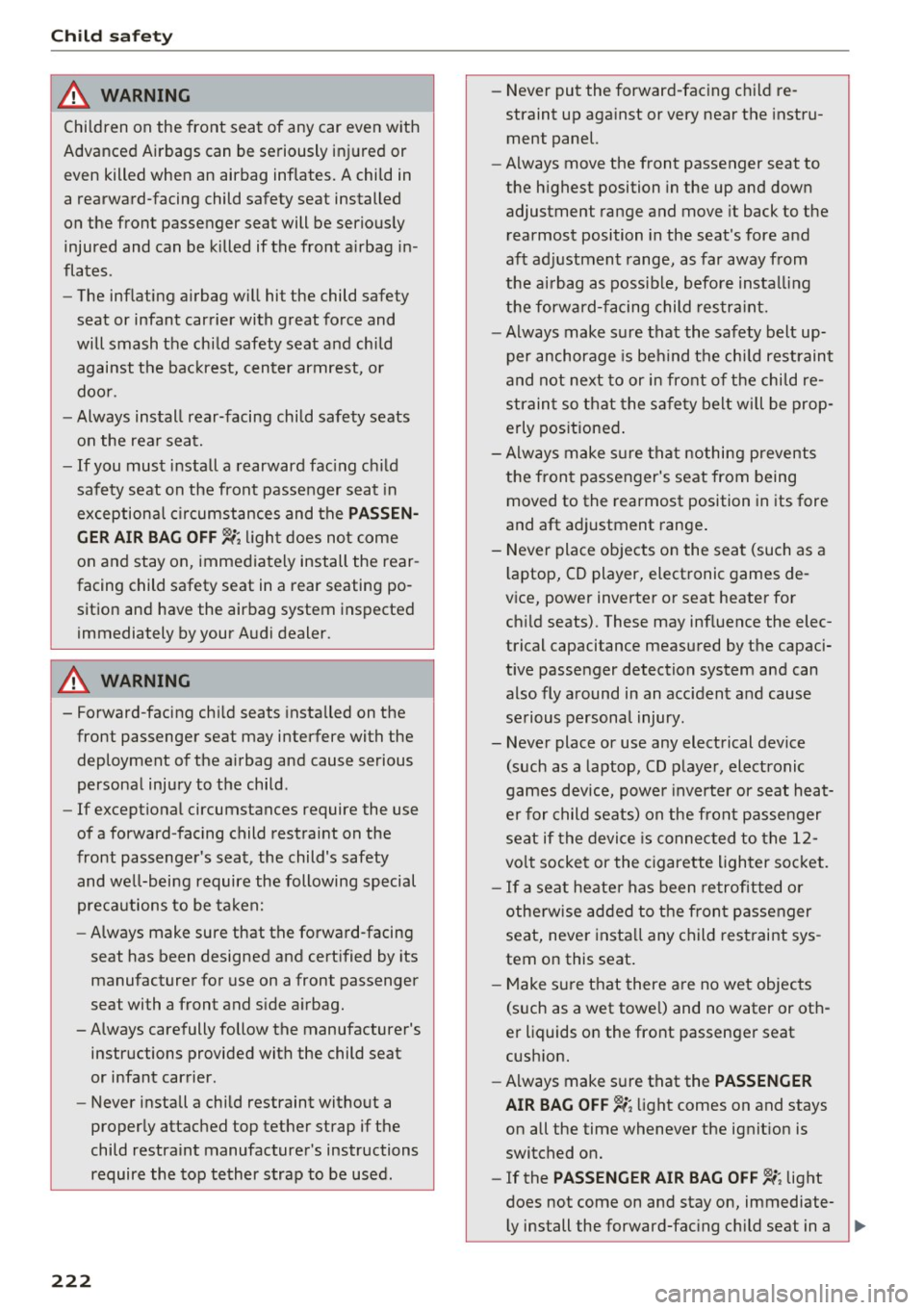
Child safety
A WARNING
Children on the front seat of any car even with
Advanced Airbags can be seriously injured or
even killed when an airbag inflates. A child in
a rearward-facing child safety seat installed
on the front passenger seat will be seriously
injured and can be killed if the front airbag in
flates.
- The inflating airbag will hit the child safety
seat or infant carrier with great force and
will smash the child safety seat and child
against the backrest, center armrest, or
door.
- Always install rear-facing child safety seats
on the rear seat.
-If you must install a rearward facing child
safety seat on the front passenger seat in
exceptional circumstances and the
PASSEN
GER AIR BAG OFF~;
light does not come
on and stay on, immediately install the rear
facing child safety seat in a rear seating po
sition and have the airbag system inspected
immediately by your Audi dealer.
A WARNING
- Forward-facing child seats installed on the
front passenger seat may interfere with the deployment of the airbag and cause serious
personal injury to the child.
- If exceptional circumstances require the use
of a forward-facing child restraint on the
front passenger's seat, the child's safety and well-being require the following special
precautions to be taken:
- Always make sure that the forward-facing
seat has been designed and certified by its
manufacturer for use on a front passenger
seat with a front and side airbag.
-Always carefully follow the manufacturer's
instructions provided with the child seat
or infant carrier.
- Never install a child restraint without a
properly attached top tether strap if the
child restraint manufacturer's instructions
require the top tether strap to be used.
222
-Never put the forward-facing child re
straint up against or very near the instru
ment panel.
- Always move the front passenger seat to
the highest position in the up and down
adjustment range and move it back to the
rearmost position in the seat's fore and
aft adjustment range, as far away from
the airbag as possible, before installing
the forward-facing child restraint.
-Always make sure that the safety belt up
per anchorage is behind the child restraint
and not next to or in front of the child re
straint so that the safety belt will be prop
erly positioned.
- Always make sure that nothing prevents
the front passenger's seat from being
moved to the rearmost position in its fore
and aft adjustment range.
- Never place objects on the seat (such as a
laptop, CD player, electronic games de
vice, power inverter or seat heater for
child seats). These may influence the elec
trical capacitance measured by the capaci
tive passenger detection system and can
also fly around in an accident and cause
serious personal injury.
- Never place or use any electrical device
(such as a laptop, CD player, electronic
games device, power inverter or seat heat
er for child seats) on the front passenger
seat if the device is connected to the 12-
volt socket or the cigarette lighter socket.
-If a seat heater has been retrofitted or
otherwise added to the front passenger
seat, never install any child restraint sys
tem on this seat.
- Make sure that there are no wet objects
(such as a wet towel) and no water or oth
er liquids on the front passenger seat
cushion.
- Always make sure that the
PASSENGER
AIR BAG OFF~;
light comes on and stays
on all the time whenever the ignition is
switched on.
- If the PASSENGER AIR BAG OFF,;; light
does not come on and stay on, immediate- ly install the forward-facing child seat in a
~
Page 225 of 322
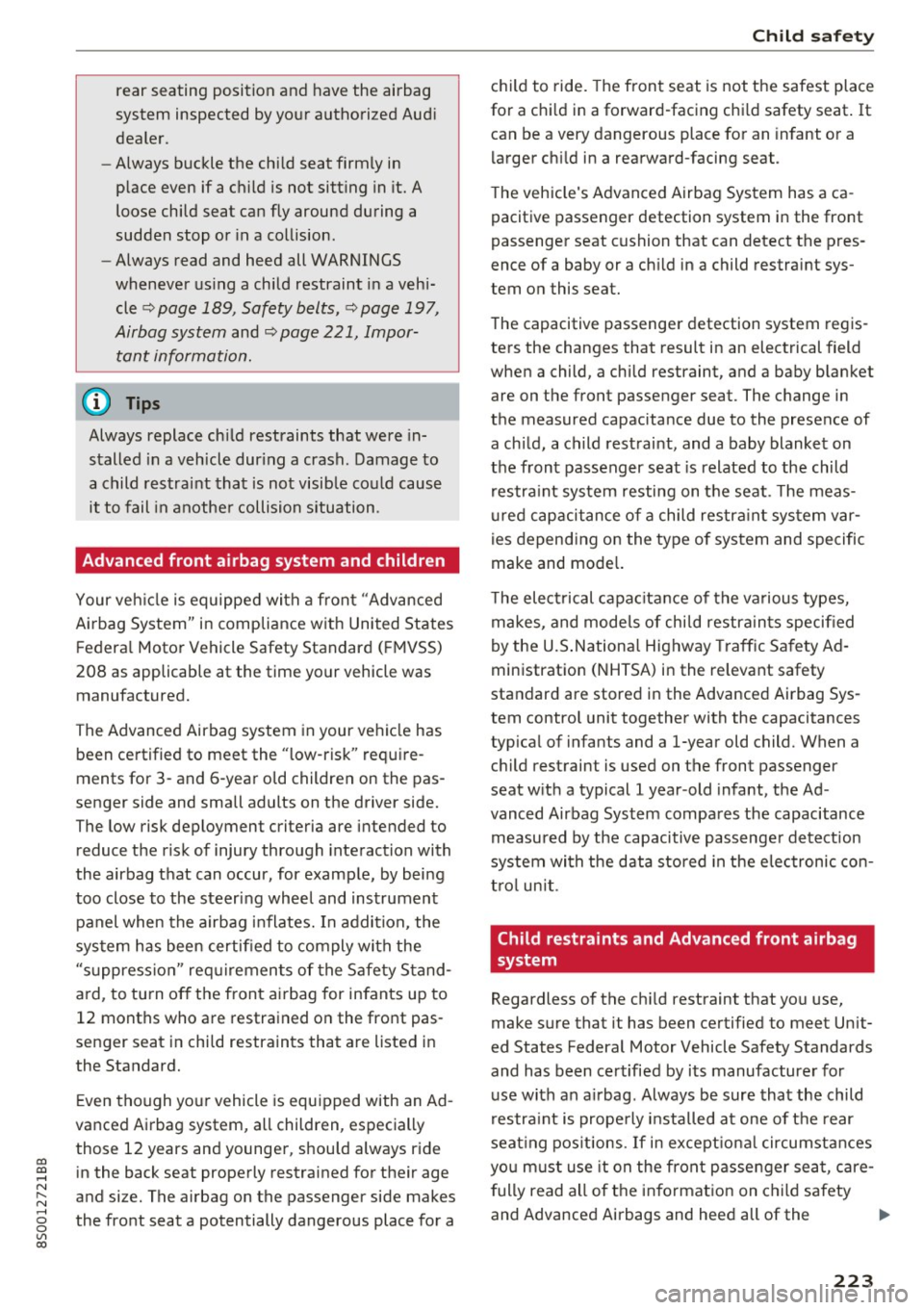
co
co
.... N
" N .... 0
0
Vl c:o
rear seating position and have the airbag
system inspected by your authorized Audi
dealer.
- Always buckle the child seat firmly in
place even if a child is not sitting in it. A
loose child seat can fly around during a
sudden stop or in a collision.
- Always read and heed all WARNINGS
whenever using a child restraint in a vehi
cle
c!;> page 189, Safety belts, c!;> page 197,
Airbag system
and c!;> page 221, Impor
tant information.
{D) Tips
Always replace child restraints that were in
stalled in a vehicle dur ing a crash. Damage to
a child restraint that is not visible could cause
it to fail in another collision situation.
Advanced front airbag system and children
Your vehicle is equipped with a front "Advanced
Ai rbag System" in compliance with United States
F edera l Motor Vehicle Safety Standard ( FMVSS)
208 as applicable at the time your vehicle was manufactured.
The Advanced Airbag system in your vehi cle has
been certified to meet the "low-risk" require
ments for 3- and 6-year old children on the pas
senger side and small adults on the driver side.
The low risk deployment criteria are intended to
reduce the risk of injury through interaction with
the airbag that can occur, for example, by being
too close to the steering wheel and instrument
panel when the airbag inflates. In addition, the
system has been certified to comply with the
"s uppress io n " req uiremen ts of the Safety Stand
ard, to turn of f the front airbag for infants up to
12 months who are restrained on the front pas
senger seat in chi ld restraints that are listed in
the Standard.
E ven though your vehicle is equipped with an Ad
vanced Ai rbag system, all children, especially
those 12 years and younger, should always r ide
in the back seat properly restrained for their age
and size. The airbag on the passenger side makes
the front seat a potentially dangerous place for a
Child safety
child to ride. The front seat is not the safest place
for a chi ld in a forward-facing chi ld safety seat . It
can be a very dangerous place for an infant or a
larger ch ild in a rearward-facing seat.
T he vehicle's Advanced A irbag System has a ca
pacitive passenger detection system in the front
passenger seat cushion that can detect the pres
ence of a baby or a ch ild in a child restraint sys
tem on this seat.
The capacitive passenger detection system regis
ters the changes that result in an electrical field
when a child, a child restraint, and a baby b lanket
are on the front passenger seat. The change in
the measured capacitance due to the presence of
a child, a ch ild restraint, and a baby blanket on
the front passenger seat is related to the child
restraint system resting on the seat . Th e meas
ur ed capacitance of a child restraint system var
ies depending on the type of system and specific
make and mode l.
T he elect rical capacitance of the various types,
makes, and models of child restra in ts specified
by the U.S .National Highway Traff ic Safety Ad
ministration (NHTSA) in the relevant safety
standard are stored in the Advanced Airbag Sys
tem control unit together with the capacitances
typ ica l of infants and a 1-year old child. When a
child restraint is used on the front passenger
seat w ith a typical 1 year -old infant, the Ad
vanced Airbag System compares the capacitance measured by the capacitive passenge r detection
system with the data stored in the electronic con
trol unit.
Child restraints and Advanced front airbag
system
Regardless of the ch ild restraint that you use,
make sure that it has been certified to meet Unit
ed States Federal Motor Vehicle Safety Standards
and has been certified by its manufacturer for
use with an a irbag. Always be sure that the child
r estra int is properly installed at one of the rear
seating positions.
If in except ional circumstances
you must use it on the front passenger seat, care
f ully read all of the information on child safety
and Advanced Airbags and heed all of the .,.
223
Page 226 of 322
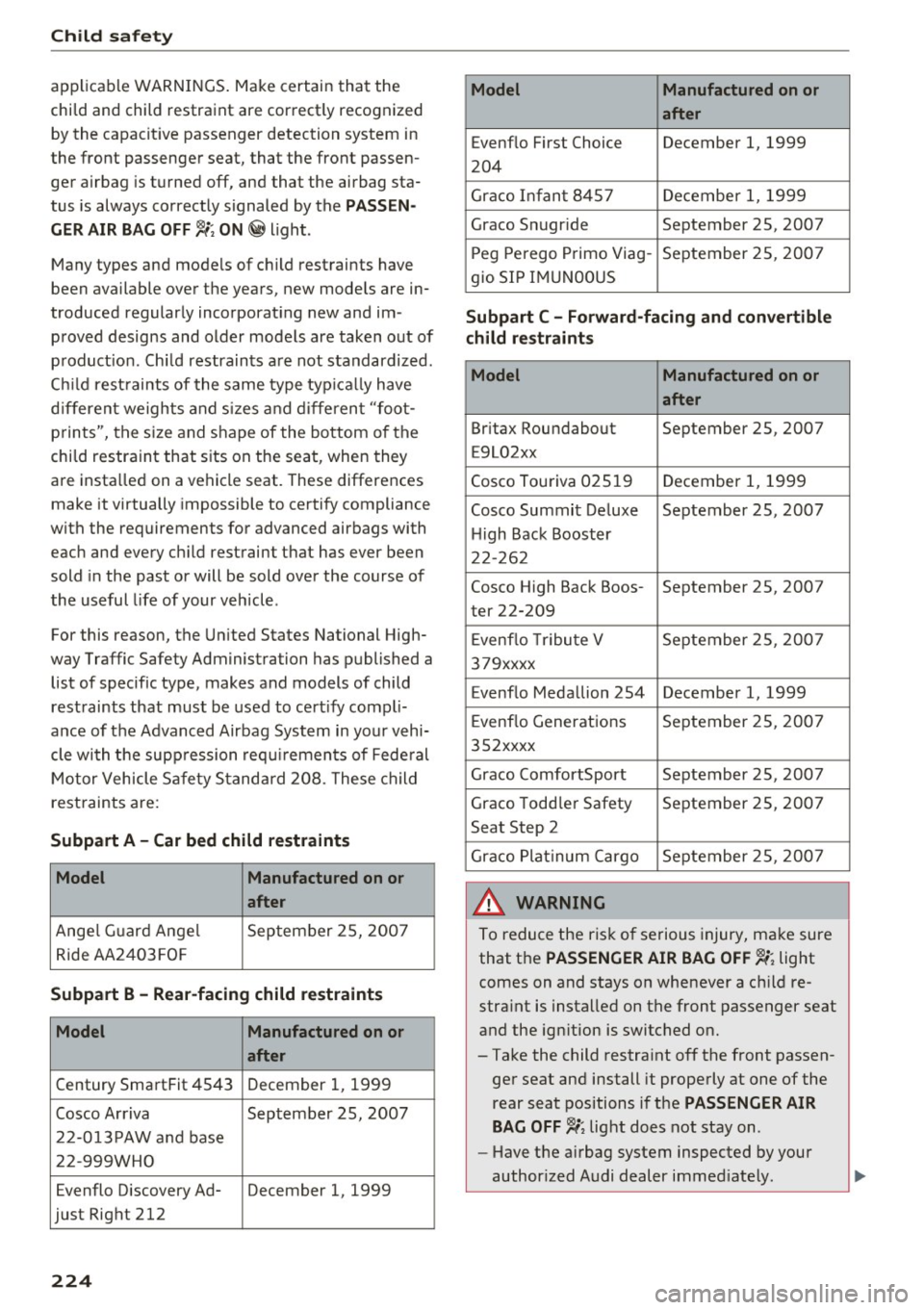
Child safet y
applicab le WARN INGS . Make certain that the
chi ld and child restraint are correct ly recognized
by the capacit ive passenger detection system in
the front passenger seat, that the front passen
ger airbag is turned off, and that the airbag sta
tus is always correctly signaled by the
PA SS EN
GER AIR BAG OFF,;; ON @
light .
Many types and models of child restraints have
been available over the years, new models are in
troduced regularly incorporat ing new and im
proved designs and older models are taken out of
p roduct ion . Ch ild restraints are not standardized.
Ch ild rest raints of the same type typ ica lly have
d ifferent weights and s izes and differen t "foot
prints", the s ize and shape of the bottom of the
child restraint that sits on the seat, when they
are insta lled on a vehicle seat. These differences
make it virtually impossible to certify compliance
with the requirements for advanced airbags with
each and every ch ild restraint that has ever been
sold in the past or will be sold over the course of
the useful life of your veh icle .
For this reason, the Un ited States National High
way Traffic Safety Administration has published a list of specific type, makes and models of child
restraints that must be used to cert ify compli
ance of the Advanced Airbag System in your vehi
cle with the supp ression requ irements of Fede ral
Motor Vehicle Safety Standard 208. These child
rest raints are :
Subpart A - Car bed child restraints
Mod el Manufactured on or
after
Angel G uard Angel September 25, 200 7
Ride AA2403 FOF
Subpart B - Rear-facing child re straints
Model Manufactured on or
after
Century SmartFit 4543 December 1, 1999
Cosco Arriva September 25, 2007
22-0 13PAW and base
22-999WHO
Evenflo Discovery Ad- December 1, 1999
just Right 212
224 Model
Manufactured on or
after
Evenflo First Choice December 1, 1999
204
Graco Infan t 845 7 December 1, 1999
Graco Snugr ide September 25, 2007
Peg Perego Primo Viag- September 25, 2007
gio SIP IMUNOOUS
Subpart C - Forward-facing and convertible
child re str aint s
Model Manufactured on or
after
Br itax Roundabout September 25, 2007
E9L02xx
Cosco Touriva 025 19
December 1, 1999
Cosco Summit Deluxe September 25, 2007 H igh Back Booster
22-262
Cosco High Back Boos- September 25, 2007
ter 22-209
E venflo Tribu te V September 25, 2007
379xxxx
Evenflo Medallion 254 December 1, 1999
Evenflo Generations September 25, 2007
352xxxx
Graco ComfortSport September 25, 2007
Graco Todd ler Safety
September 25, 2007
Seat Step 2
Graco Plat inum Cargo September 25, 200 7
_&. WARNING
To reduce the risk of serious injury, ma ke sure
that the
PASSENGER AIR BAG OFF,;; light
comes on and stays on whenever a ch ild re
stra int is installed on the front passenger seat
and the ign ition is switched on.
-Take the child restra int off the front passen
ger seat and install it properly at one of the rear seat positions if the
PA SSENGER AIR
BAG OFF,;;
light does not stay on .
- Have the airbag system inspected by your
author ized Audi dealer immed iately.
Page 227 of 322
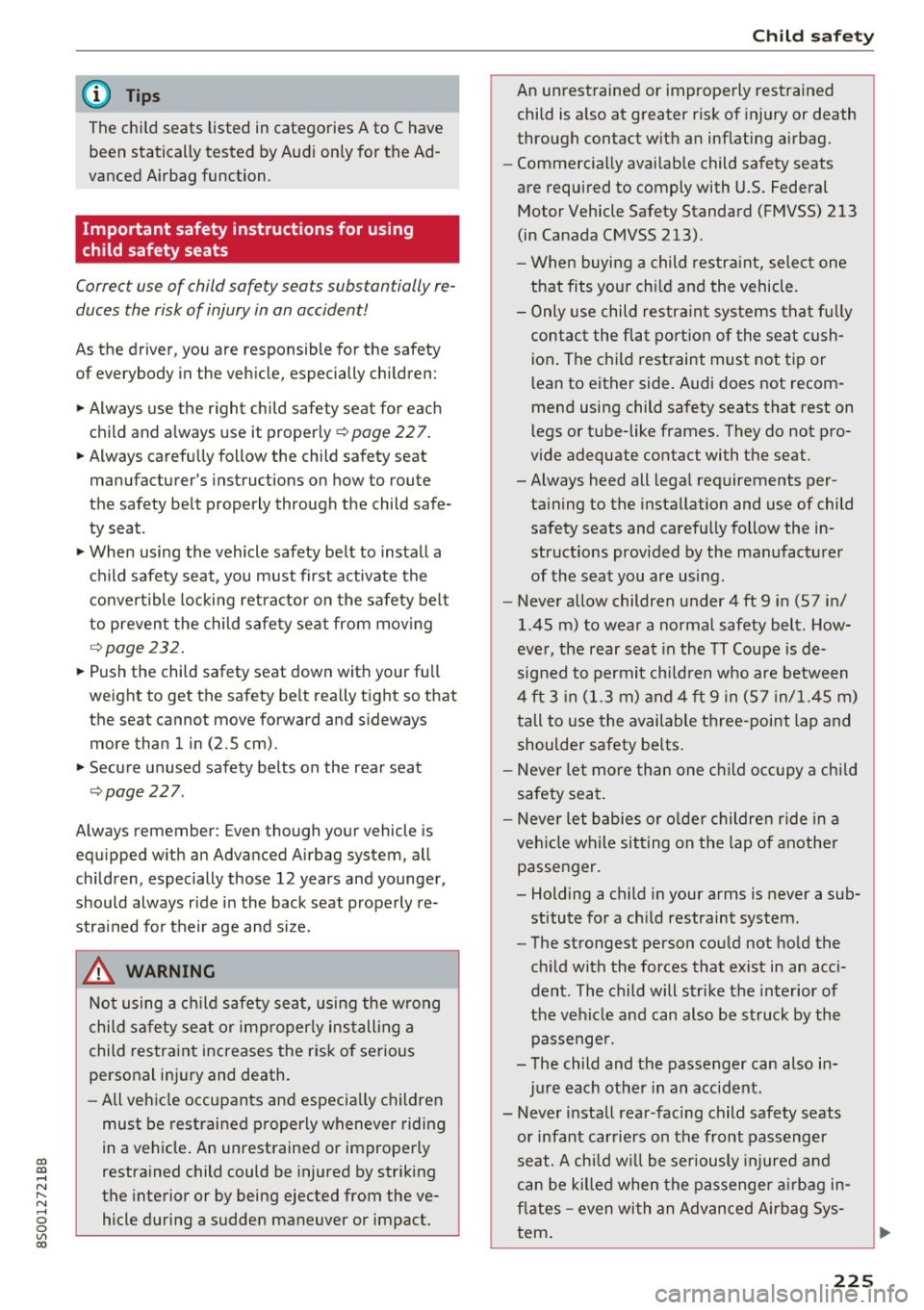
co
co
.... N
" N .... 0
0
Vl c:o
@ Tips
The chi ld seats listed in categories A to C have
been statically tested by Audi only for the Ad
vanced Airbag function .
Important safety instructions for using
child safety seats
Correct use of child safety seats substantially re
duces the risk of injury in an accident!
As the driver, you are responsible for the safety
of everybody in the vehicle, especially children:
~ Always use the right child safety seat for each
child and a lways use it properly~
page 22 7.
~ Always carefully follow the child safety seat
manufacturer's instructions on how to route
the safety belt properly through the child safe
ty seat .
~ When using the vehicle safety be lt to install a
child safety seat , you must first activate the
convertible locking retractor on the safety be lt
to prevent the child safety seat from moving
~ page 232.
~ Push the child safety seat down w ith your full
weight to get the safety be lt rea lly t ight so that
the seat cannot move forward and sideways more than 1 in (2 .5 cm).
~ Secure unused safety belts on the rear seat
~ page 227.
Always remember: Even though your vehicle is
equipped with an Advanced Airbag system, all
children, especially those 12 years and younger,
should always ride in the back seat properly re
stra ined for their age and size.
_&, WARNING
Not using a ch ild safety seat , using the w rong
child sa fety seat or imp roperly installing a
child restraint increases the risk of serious
personal injury and death.
- All vehicle occupants and especia lly children
must be restrained properly whenever riding
in a vehicle . An unrestrained or improperly
restrained child could be injured by striking
the interior or by being ejected from the ve hicle during a sudden maneuver or impact.
Ch ild safety
An unrestrained or improperly restrained
child is also at greater r isk of injury or death
through contact with an inf lating airbag.
- Commercially available child safety seats
are required to comply with U.S . Federal
Motor Vehicle Safety Standard (FMVSS) 213
(in Canada CMVSS 213) .
- When buying a child restra int, select one
that fits your chi ld and the vehicle.
- Only use child restraint systems that fully
contact the flat portion of the seat cush
ion . The child restraint must not tip or
lean to either side. Audi does not recom
mend using child safety seats that rest on
legs or tube-like frames. They do not pro
vide adequate contact with the seat.
- Always heed all lega l requirements per
ta ining to the insta llation and use of child
safety seats and carefully follow the in
structions provided by the manufacturer
of the seat you are using .
- Never allow children under 4 ft
9 in (57 in/
1.45 m) to wear a normal safety belt . H ow
eve r, the rear seat in the TT Coupe is de
signed to permit children who are between
4 ft 3 in (1.3 m) and 4
ft 9 in (57 in/1.45 m)
tall to use the available three-point lap and
shoulder safety belts.
- Never let more than one child occupy a chi ld
safety seat .
- Never let babies or o lder children ride in a
veh icle while sitting on the lap of another
passenger.
- Holding a child in your arms is never a sub
stitute for a child restraint system .
- The strongest person cou ld not ho ld the
ch ild with the forces that exist in an acci
dent . The child will strike the interior of
the vehicle and can also be struck by the passenger.
- The child and the passenger can also in
jure each other in an accident.
- Never install rear-fac ing child safety seats
or infant car riers on the front passenger
seat. A child w ill be seriously injured and
can be killed when the passenger a irbag in
flates -even with an Advanced Airbag Sys
tem .
225
Page 228 of 322
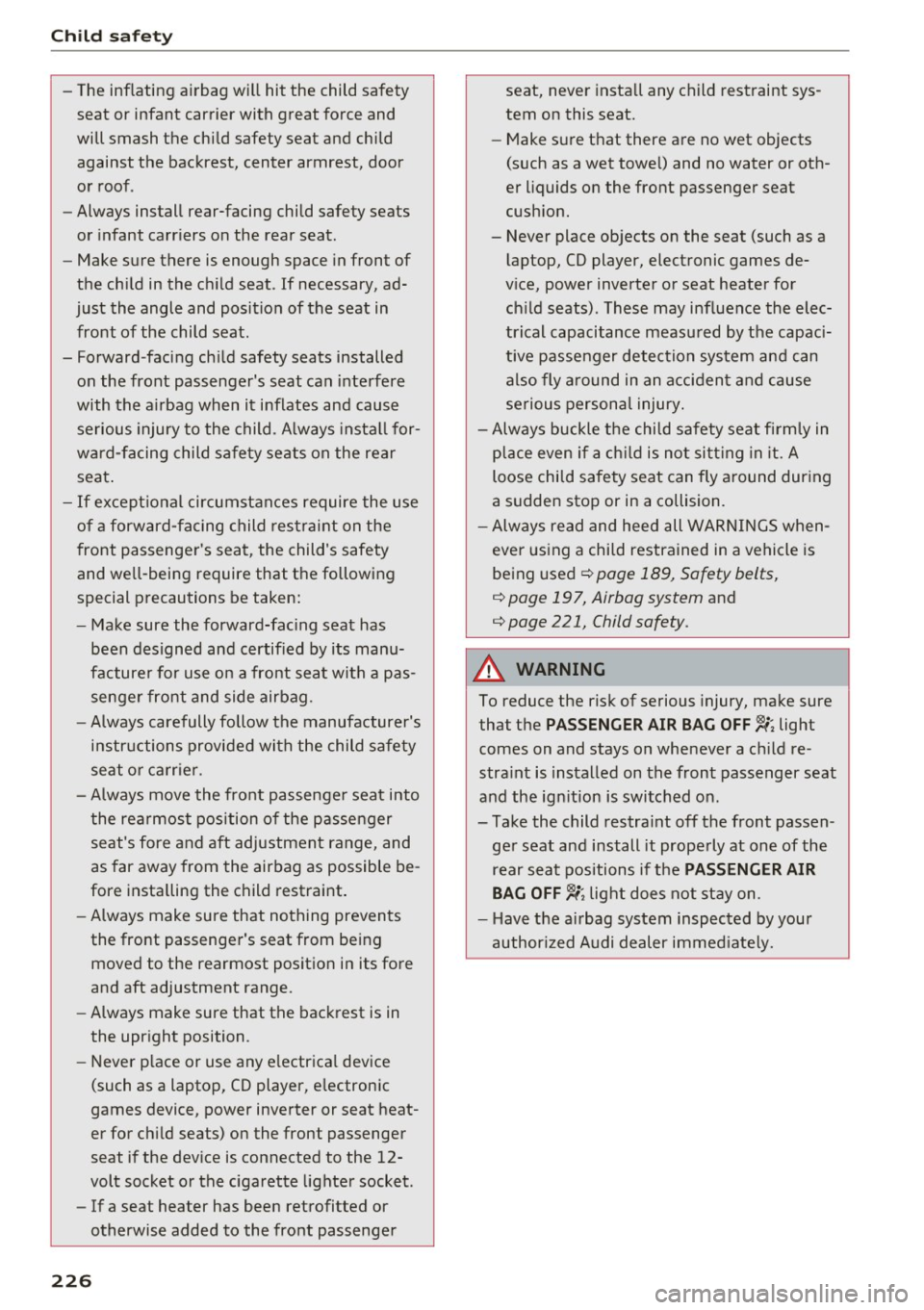
Child safety
-The inflating airbag will hit the child safety
seat or infant carrier with great force and
will smash the child safety seat and child
against the backrest, center armrest, door
or roof .
- Always install rear-facing child safety seats
or infant carriers on the rear seat .
- Make sure there is enough space in front of
the child in the child seat . If necessary, ad
just the angle and position of the seat in front of the child seat.
- Forward -facing child safety seats installed
on the front passenger's seat can interfere
with the airbag when it inflates and cause serious injury to the child . Always install for
ward-facing child safety seats on the rear
seat.
- If exceptional circumstances require the use
of a forward-facing child restraint on the
front passenger's seat, the child's safety and well-being require that the following
special precautions be taken:
- Make sure the forward-facing seat has
been designed and certified by its manu
facturer for use on a front seat with a pas senger front and side airbag .
- Always carefully follow the manufacturer's
instructions provided with the child safety
seat or carrier .
- Always move the front passenger seat into
the rearmost position of the passenger
seat's fore and aft adjustment range, and
as far away from the airbag as possible be
fore installing the child restraint.
- Always make sure that nothing prevents
the front passenger's seat from being
moved to the rearmost position in its fore
and aft adjustment range .
- Always make sure that the backrest is in
the upright position .
- Never place or use any electrical device
(such as a laptop, CD player, electronic
games device, power inverter or seat heat
er for child seats) on the front passenger
seat if the device is connected to the 12-
volt socket or the cigarette lighter socket.
- If a seat heater has been retrofitted or
otherwise added to the front passenger
226
seat, never install any child restraint sys
tem on this seat.
- Make sure that there are no wet objects
(such as a wet towel) and no water or oth
er liquids on the front passenger seat
cushion.
- Never place objects on the seat (such as a
laptop, CD player, electronic games de
vice, power inverter or seat heater for
child seats) . These may influence the elec
trical capacitance measured by the capaci
tive passenger detection system and can
also fly around in an accident and cause
serious personal injury.
- Always buckle the child safety seat firmly in
place even if a child is not sitting in it. A
loose child safety seat can fly around during
a sudden stop or in a collision .
-Always read and heed all WARNINGS when
ever using a child restrained in a vehicle is
being used
c::!;> page 189, Safety belts,
c::!;> page 197, Airbag system and
c::!;> page 221, Child safety .
A WARNING
To reduce the risk of serious injury, make sure
that the
PASSENGER AIR BAG OFF '-i; light
comes on and stays on whenever a child re
straint is installed on the front passenger seat
and the ignition is switched on.
-Take the child restraint off the front passen
ger seat and install it properly at one of the
rear seat positions if the
PASSENGER AIR
BAG OFF
'-i; light does not stay on .
- Have the airbag system inspected by your
authorized Audi dealer immediately.
Page 229 of 322
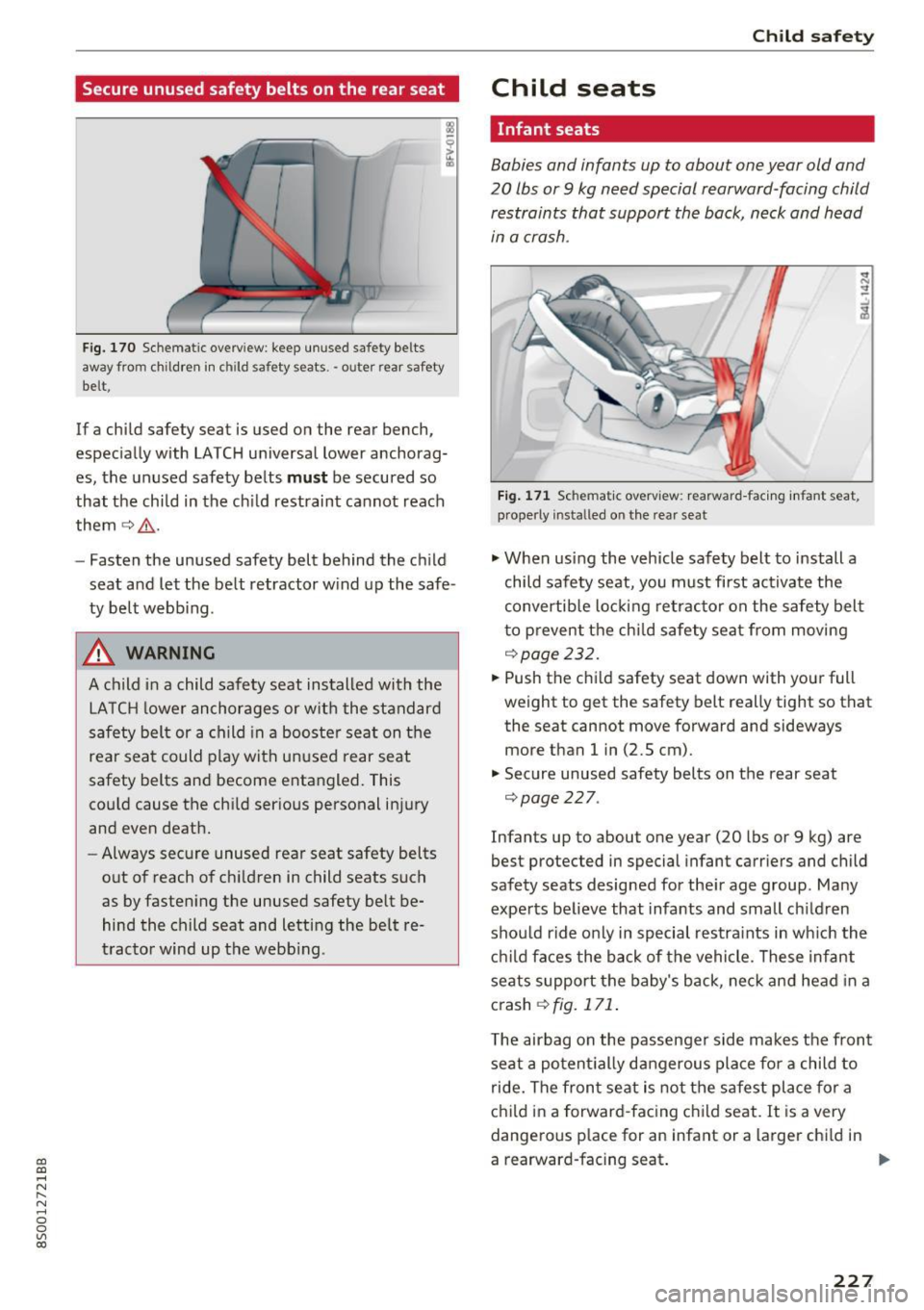
CD
CD
.... N
" N .... 0
0
Ill co
Secure unused safety belts on the rear seat
Fig. 170 Sche matic overview : keep unu sed sa fety belt s
away from c hildre n in c hild safety seats .· outer rear safety
belt,
If a child safety seat is used on the rear bench,
especially with LATCH universal lower anchorag
es, the unused safety belts
mu st be secured so
that the child in the ch ild restraint cannot reach
them 9&, .
- Fasten the unused safety belt behind the child
seat and let the be lt retractor w ind up the safe
ty be lt webbing.
.,&. WARNING
A child in a child safe ty seat ins talled with the
LA TC H l ower anchorages or w ith the standard
safety belt or a ch ild in a booste r seat on the
rear seat could play with u nused rear seat
safety belts and become entangled. This
co uld cause the chi ld serious personal in jury
and even death.
- Always secure unused rear seat safety belts
out of reach of chi ldren in child seats such
as by fastening the unused safety belt be
hind the child seat and letting the belt re·
tractor wind up the webb ing .
Ch ild sa fety
Child seats
Infant seats
Babies and infants up to about one year old and
20 lbs or
9 kg need special rearward -facing child
restraints that support the back , neck and head
in a crash .
Fig . 17 1 Schem atic overv ie w : rearward -fac ing in fan t seat,
p rope rly i nsta lled o n the rea r sea t
.,. When using the vehicle safety belt to install a
child safety seat, yo u must first activate the
convertib le loc king re tractor on the safety belt
to p revent the ch ild safety seat from moving
9 page232 .
.,. Push the ch ild safety seat down with your full
weight to g et the saf ety belt really tight so that
the seat cannot move forward and sideways
more than 1 in (2.5 cm) .
"' Secure unused safety belts on the rear seat
~ page 227.
Infants up to about one yea r (20 lbs or 9 kg) a re
best protected in special infant carr iers and child
safety seats designed for the ir age group. Many
expe rts believe that infants and small ch ild ren
shou ld ride o nly in special restra ints in wh ich the
ch ild fa ces the back of the vehicle. These infant
seats support the baby's back, neck and head in a
crash
~ fig. 171 .
The airbag on the passenge r side makes the front
sea t a potent ially dangerous place for a child to
ride. The fron t seat is not the safest place for a
c h ild in a forward -fac ing ch ild seat. It is a
very
dange rous p lace for an infant or a larger chi ld in
a rearward-fac ing seat . .,..
227
Page 230 of 322
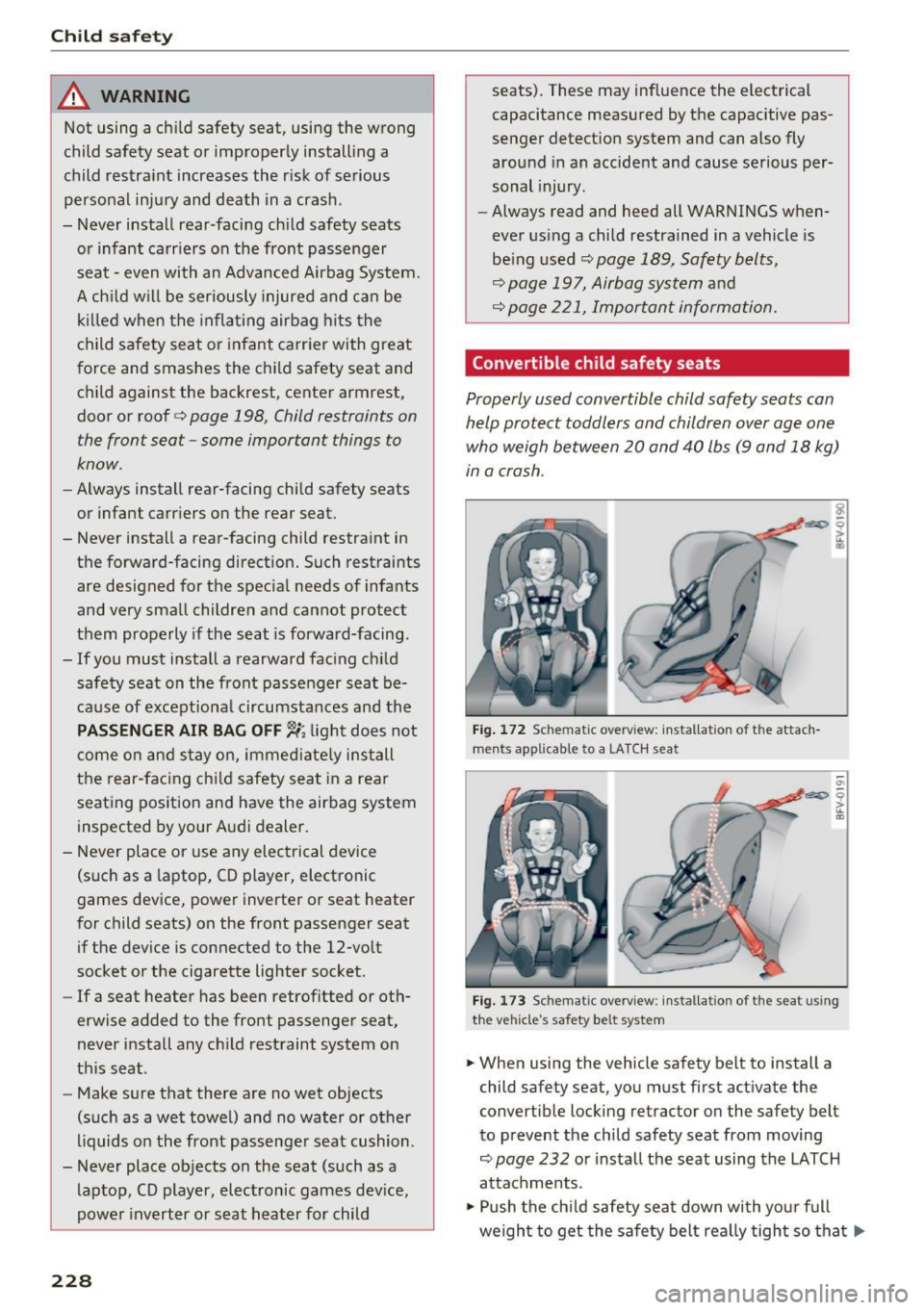
Child safety
_& WARNING
Not using a child safety seat, using the wrong
child safety seat or improperly install ing a
child restra int increases the risk of serious
personal injury and death in a crash.
- Never install rear-facing child safety seats or infant carr iers on the front passenger
seat -
even with an Advanced Airbag System.
A chi ld will be seriously injured and can be
k illed when the inflating airbag hits the
child safety seat or infant carrier with great
force and smashes the child safety seat and
child against the backrest, center armrest,
door or roof
c::> page 198, Child restraints on
the front seat -some important things to
know.
- Always install rear-facing child safety seats
or infant carr iers on the rear seat.
- Never install a rear-facing child restraint in
the forward-facing direction. Such restraints
are designed for the spec ial needs of infants
and
very small children and cannot protect
them properly if the seat is forward-facing.
- If you must install a rearward fac ing ch ild
safety seat on the front passenger seat be
cause of exceptional circumstances and the
PAS SENGER AIR BAG OFF~; light does not
come on and stay on, immed iate ly install
the rear-facing child safety seat in a rear
seat ing position and have the airbag system
inspected by your Audi dealer.
- Never place or use any electrical device (such as a laptop, CD player, electronic
games device, power inverter or seat heater
for child seats) on the front passenger seat
if the device is connected to the 12-volt
socket or the cigarette lighter socket.
- If a seat heater has been retrofitted or oth
erwise added to the front passenger seat,
never install any ch ild restraint system on
th is seat.
- Make sure that there are no wet objects
(such as a wet towel) and no water or other
liquids on the front passenger seat cushion.
- Never place objects on the seat (such as a
laptop, CD player, electronic games dev ice,
power inverter or seat heater for child
228
seats). These may inf luence the electrical
capacitance measured by the capacitive pas
senger detect ion system and can also fly
around in an accident and cause serious per
sonal injury.
-Always read and heed all WARNINGS when
ever using a child restrained in a vehicle is
be ing used
c::> page 189, Safety belts,
c::>page 197, Airbag syste,n
and
c::>page 221, Important information.
Convertible child safety seats
Properly used convertible child safety seats can
help protect toddlers and children over age one who weigh between 20 and 40 lbs (9 and 18 kg)
in a crash.
Fig . 172 Schematic overview: installat ion of the attach
me nts applicable to a LATCH seat
Fig. 173 Schemat ic overv iew: installation of the seat using
the vehicle's safety belt system
.,. When using the vehicle safety belt to install a
child safety seat, you must first activate the
convertible locking retractor on the safety belt
to prevent the child safety seat from moving
c::>page 232 or install the seat using the LATCH
attachments.
.,. Push the child safety seat down wi th yo ur full
weight to get the safety belt rea lly tight so that
Iii>